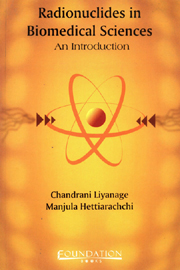Book contents
- Frontmatter
- Contents
- Forewords
- Introduction
- 1 Atomic and Nuclear Structure
- 2 Radiation Detectors
- 3 Units of Radiation Measurements
- 4 Iodine–125
- 5 Radioimmunoassay
- 6 Quality Control in RIA
- 7 Radiolabelled Compounds
- 8 Radiation Safety
- 9 Radiation Protection
- 10 Background Radiation
- 11 Storage
- 12 Contamination
- 13 Radioactive Waste
- References
Forewords
Published online by Cambridge University Press: 26 October 2011
- Frontmatter
- Contents
- Forewords
- Introduction
- 1 Atomic and Nuclear Structure
- 2 Radiation Detectors
- 3 Units of Radiation Measurements
- 4 Iodine–125
- 5 Radioimmunoassay
- 6 Quality Control in RIA
- 7 Radiolabelled Compounds
- 8 Radiation Safety
- 9 Radiation Protection
- 10 Background Radiation
- 11 Storage
- 12 Contamination
- 13 Radioactive Waste
- References
Summary
This book by Dr Chandrani Liyanage and Dr. Manjula Hettiarachchi of the University of Ruhuna is the one of the many ‘non-power’ applications of nuclear technology. Although not widely known, nuclear technology is used for a large number of purposes other than power generation; the use of nuclear tracers in biomedicine is one such application.
This book gives an introduction to the basis of radioactivity and describes radiation detectors and counters used in biomedical applications. It also explains the theory and practice of radioimmunoassay, which is a very powerful in vitro technique for biomedical assays. The authors have also taken care to include a chapter on radiation protection and waste management which are essential components of any applications of nuclear technology.
Dr Liyanage presently functions as the Head of the Nuclear Medical Unit of the Faculty of Medicine of University of Ruhuna, which was established with the technical assistance provided by the International Atomic Energy Agency (IAEA) through the Atomic Energy Authority of Sri Lanka.
Dr Liyanage received valuable training with a fellowship awarded by the IAEA. In Sri Lanka, she had the privilege of being trained by Dr Rienzil Piyasena, a person responsible for introducing Radioimmunoassay to a large number of countries during his long and distinguished service in the Division of Human Health of the International Atomic Energy Agency. Additionally, Dr Liyanage's experience in establishing and supervising the Radioimmunoassay Laboratory, has made it possible for her to co-author a book that will be most useful for those who intend to use radioimmunoassay for diagnostic purposes.
- Type
- Chapter
- Information
- Radionuclides in Biomedical SciencesAn Introduction, pp. vii - xPublisher: Foundation BooksPrint publication year: 2008

